Top 10 Attractions in Yesan
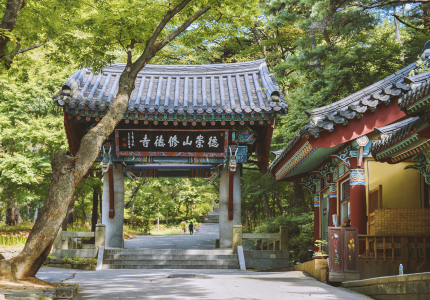
79, Sudeoksaan-gil, Deoksan-myeon, Yesan-gun, Chungcheongnam-do (20 Sacheon-ri)
Sudeoksa is situated in a place where mountains and the sea harmonize, and low hills connect to flat fields, with streams flowing through every valley. Historically, this place was referred to as Sogeumgang, and it is here that the enlightened virtue of Buddhism has been diligently carried on and produced many eminent monks, thereby establishing Sudeoksa as a central monastery of Korean Son Buddhism.
Sudeoksa, a Baekje temple, is believed by scholars to have been established during the reign of King Wideok (554-597) of Baekje. Moreover, the Baekje tower discovered on the old temple grounds of Sudeoksa corroborates the establishment of the temple during the Baekje era. During the reign of King Mu (600-641) of Baekje, the monk Hyehyeon taught here, and during the reign of King Gongmin of Goryeo, the monk Naong rebuilt the temple. The temple gained fame as a Son Buddhism capital of Korea when Monk Mangong rejuvenated it in the second year of King Gojong’s reign (1865).
Sudeoksa follows the gentle slopes of Deoksung Mountain with a three-tiered stone structure that has the Daeungjeon (main hall) at the very top, embodying a typical mountain temple layout that demonstrates a sequence of introduction, development, and conclusion. The introductory part consists of Iljumun and Hwanghajeongru, which serve as the gateway from the secular world to the temple. The development section leads to the Joingjeongsa, which induces a sudden change in scenery and focuses attention, while the concluding section emphasizes the role and function of the core space, the Daeungjeon, and completes the layout with excellent structural beauty through the arrangement of the circuit.
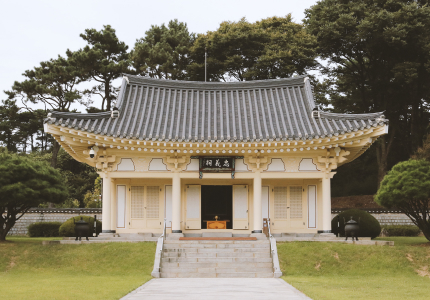
183-5, Deoksan-Oncheon-ro, Deoksan-myeon, Yesan-gun, Chungcheongnam-do (119-1 Silyang-ri)
Dr. Yun Bong-gil was born as the eldest son of Yun Hwang-gong on June 21, 1908, during the second year of Emperor Sunjong's reign, in his native house in Dojungdo. At the age of 15, he was recognized for his exceptional academic abilities and was considered a prodigy. At the age of 19, he established a night school to combat illiteracy in 1926 and in 1927, he authored reading material for farmers and organized reading groups.
On March 6, 1930, he left a poignant will titled "Departure for the Battlefield, No Return" and embarked on the path of exile. On April 29, 1932, he carried out a heroic act by detonating a bomb at the celebratory venue for the victory of the April 29th Incident at Hongkou Park in Shanghai, China. Subsequently, he met his end for the cause of his country on December 19, 1932 at the age of 25.
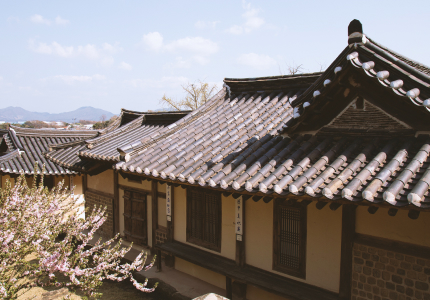
261, Chusa-gotek-ro, Sinam-myeon, Yesan-gun, Chungcheongnam-do
The main building of Chusa Gotek comprises a six-kan (unit of measurement) daecheong (main wooden floor), two kan of inner rooms, and a geonnanbang (room across), forming a “ㅁ”-shaped house complete with a kitchen, inner gate, and side gate. Each of the inner rooms and the room across have their own wooden-floored verandas, while the kitchen ceiling is designed as an attic. The daecheong between the inner rooms and the room across is of an uncommon scale. Such “ㅁ”-shaped houses are typical of the so-called "large-roofed houses" distributed in the central and Yeongnam regions.
The sarangchae (men's quarters) has one heated room to the south, two to the east, with the rest being daecheong and wooden-floored verandas. Originally, the main building and sarangchae were strictly separated according to the Joseon-era household concept based on Confucian ethical values. In front of the stone steps of the sarangchae, there is a stone pillar known as seoknyeon (stone year), which was uniquely crafted by Chusa as a sundial using shadows to tell time.
As you walk through the house, which is imbued with Chusa's wisdom and elegance, you will be filled with emotion from the works and touches of Chusa on each pillar.
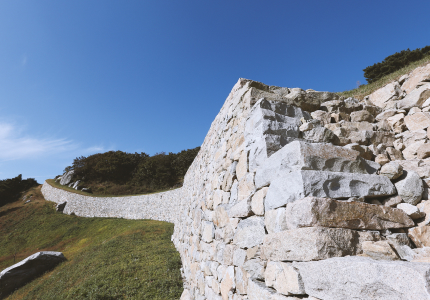
Sangjung-ri, Daeheung-myeon, Yesan-gun, Chungcheongnam-do (Bongsusan Mountain)
The height of the fortress walls ranges from approximately 250 to 350 cm, with a width of about 350 cm. The outer surface of the southern wall is built with stone, while the inner surface is a mixed construction of earth and stone, creating a retaining structure. A water gate has been installed on the southern wall, and there is a trench with a depth of 90 cm and a width of 60 cm to channel water into the fortress.
Above this trench, broad flat stones cover the surface, and the dimensions of the water gate are 70 cm in width and 30 cm in height. A unique feature of this fortress is the reinforcement of its four corners with approximately 2 meters thicker structures compared to other areas, and the overall height of the fortress walls has also been built slightly higher.
The main entrance of the fortress is presumed to be at the southern gate, where the vicinity is thicker, and stone structures, believed to be parts of the fortress gates, are visible on either side. There is also a spot presumed to be the northern gate. The terrain gently slopes inside the fortress, and fragments of pottery and roof tiles from the Baekje era are occasionally noticeable in the southern wall, along with remnants of terraced building foundations. It has been documented in various texts that this fortress, along with the Geonjisan Fortress in Seocheon, was a stronghold for the Baekje revival army.
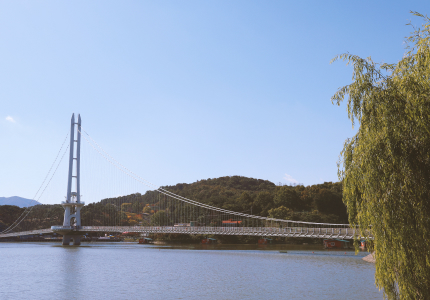
Eungbong-myeon, Yesan-gun, Chungcheongnam-do
Along with ice fishing in winter, Yedang Reservoir offers continuous fishing opportunities from early spring to late autumn. It has a variety of freshwater fish including carps, crucian carps, eels, loaches, gobies, and mudfish. It was designated and developed as a National Tourist Site in 1986, plays a role as a variety of recreational areas. More than 100 individual fishing platforms, docks, and boat platforms are distributed throughout the region and are available for rent at any time. Its popularity is further enhanced with nearby attractions such as Sudeoksa, Chunguisa, Deoksan Hot Springs, Deoksung Mountain, and Imjonsung (Imjon Fortress).
Not only is Yedang Reservoir ideal for fishing, but it is also well-suited for leisurely walks in the vicinity. The walking path around the reservoir is suitable for walking for about an hour and provides a tranquil experience. As you walk leisurely, you can appreciate several sculptures along the way and relish the natural beauty of the expansive lake and the surrounding forest.
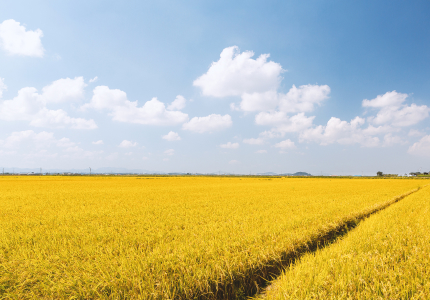
Yong-ri, Godeok-myeon, Yesan-gun, Chungcheongnam-do
The Sapgyo Plains, stretching along the Sapgyo Stream, consist of flatlands spanning Sapgyo-eup Yongdong-ri, Seong-ri, Godeok-myeon Yong-ri, Guman-ri, Sangjang-ri, and Daecheon-ri. The expansive Sapgyo Plains, seen from the peak of Sapgyo Flower Mountain in the early autumn morning sunlight, create a majestic view resembling undulating golden waves.
Based on the clear water of Yedang Reservoir and its abundant irrigation resources, high-quality rice is produced from the fertile land of these golden fields. This rice, known as "Golden Rice," is the epitome of clean, premium quality rice. It is processed and sorted in a well-equipped comprehensive grain processing facility to ensure freshness and a superior taste.
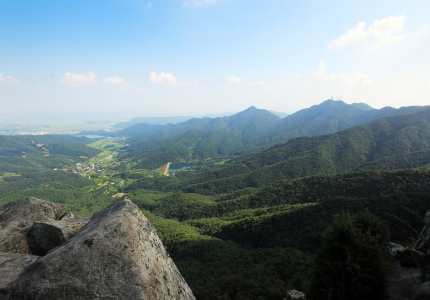
401, Gayasan-ro, Deoksan-myeon, Yesan-gun, Chungcheongnam-do
Gayasan Temple was built here during the Silla era, and national ceremonies were conducted where the Deoksan County magistrate held ceremonies in spring and autumn, a tradition that continued up to the Joseon era. The azaleas and silver grass along the ridgeline add to the joy of mountain hiking. Although it is a 600-meter class mountain, it offers a surprising sense of altitude, because unlike inland mountains it is close to the sea, resulting in a relatively higher elevation above sea level.
Most mountain hikes start or end with a course going from Namyang Gunmu to Seokmunbong through the valley and ascending to Seokmunbong near Anbu. Seokmunbong is the peak with the most rocks in Gayasan, from where a ridgeline leads to Okyangbong.
Although the distance between these peaks may appear far while on the mountain, it actually takes less than an hour to traverse. With well-organized signboards and hiking trails, it is conducive to family hiking, and you can also enjoy numerous cultural heritage sites nearby after hiking, which enhances the joy of hiking.
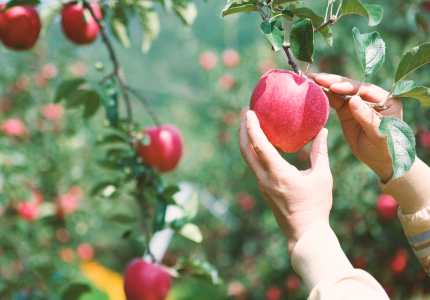
The apple cultivation area in the county peaked at 2,184 hectares in 1995, but is currently reduced to 1,190 hectares, with 949 farms engaged in apple farming. Since 2009, new varieties such as Envy and red-fleshed apples have been introduced and cultivated. By establishing the nation’s leading advanced apple cultivation zone, the reputation of Yesan apples has been widely acclaimed and continues to flourish.
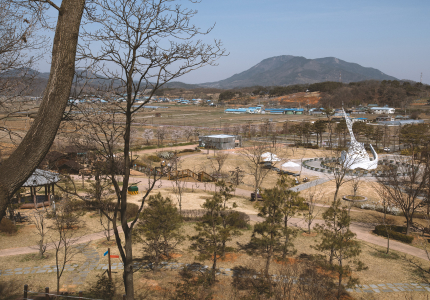
62-19, Shimokdae-ri-gil, Gwangsi-myeon, Yesan-gun, Chungcheongnam-do
Yesan Stork Park was established as part of a restoration project for the successful revival and reintroduction of the stork Natural Monument No. 199, , which faced extinction due to environmental degradation. In 2009, it was selected as a site for a stork village creation project by the Cultural Heritage Administration, and in 2014, it became the first of its kind to be established nationwide. Yesan-gun county is striving to create a habitat conducive for storks to thrive again, including the practice of eco-friendly agriculture. In Yesan Stork Park, visitors can encounter the graceful storks in person. It is highly recommended to listen to the explanations provided by the on-site ecological interpreters residing in the Stork Culture Center to fully grasp the value and significance of this place.
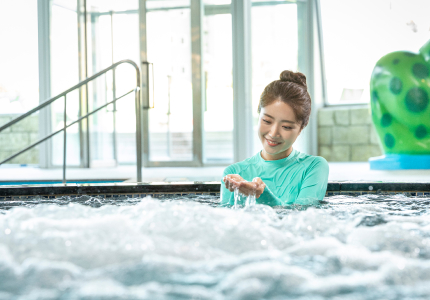
415, Sadong-ri, Deoksan-myeon, Yesan-gun, Chungcheongnam-do
Deoksan Hot Springs, featuring a natural sodium bicarbonate hot spring, was first opened (baths) to the public in 1917 by a Japanese individual named An Jung (安井). This hot spring contains germanium, often referred to as a miraculous healing element, which is known for its efficacy in alleviating muscle pain, arthritis, neuralgia, promoting blood circulation, reducing subcutaneous fat, and stimulating cell regeneration. With these health benefits, it attracts around 2.5 million visitors annually as a representative tourist destination in Yesan. The hot spring area is equipped with seven hot spring facilities, two tourist hotels, one general hotel, and more than 50 various accommodations including restaurants and convenience facilities.